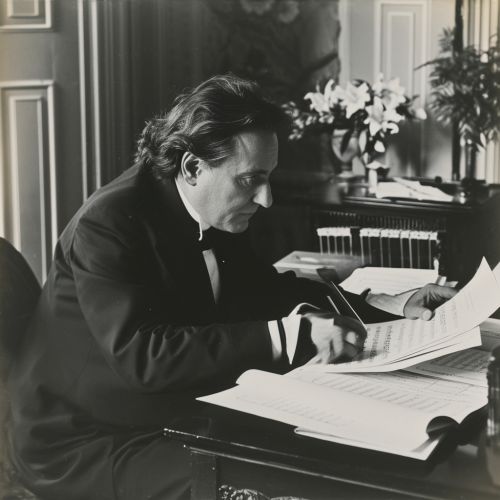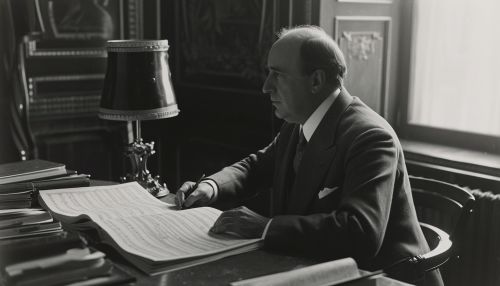Alban Berg
Early Life and Education
Alban Berg was born on February 9, 1885, in Vienna, Austria. He was the third of four children of Conrad Berg, a prosperous export merchant, and his wife Johanna, née Braun. Despite his family's financial stability, Berg's childhood was troubled. His father was often absent, and his mother suffered from mental illness.
Berg received his early education at home from private tutors. His formal education began at the age of ten when he was enrolled in the Vienna Gymnasium. He showed an early aptitude for music, and by the age of fifteen, he was already composing his own pieces.
In 1904, Berg met Arnold Schoenberg, a composer and music theorist who would have a profound influence on his development as a musician. Schoenberg accepted Berg as a student, and for the next six years, he studied music theory, harmony, and composition under Schoenberg's tutelage.


Career
Berg's first publicly performed work was the piano sonata, Op. 1, premiered in 1911. The piece was well received, and it marked the beginning of Berg's career as a professional composer.
During World War I, Berg served in the Austrian Army. His experiences during the war deeply affected him and influenced his later works. After the war, Berg returned to Vienna and resumed his career as a composer.
In the 1920s, Berg achieved international recognition with his opera Wozzeck, which premiered in Berlin in 1925. The opera, based on the play "Woyzeck" by Georg Büchner, is considered one of the most significant works of the 20th century.
Berg's other notable works include the Lyric Suite for string quartet, the Chamber Concerto for piano, violin, and 13 wind instruments, and the opera Lulu, which remained unfinished at the time of his death.
Style and Influence
Berg's music is characterized by its complexity and emotional intensity. He was a key figure in the development of the twelve-tone technique, a method of composition that uses a series of twelve pitches in a specific order as the basis for a piece of music.
Berg's music often reflects his personal experiences and emotions. His works are known for their dramatic structure and deep psychological insight. Despite the complexity of his music, Berg's works are noted for their lyricism and expressive power.
Berg's influence on the development of 20th-century music is significant. His innovative use of the twelve-tone technique and his blending of traditional and modern elements in his compositions have had a lasting impact on subsequent generations of composers.
Personal Life and Death
Berg married Helene Nahowski in 1911. The couple had no children. Berg was known to have had several extramarital affairs, most notably with Hanna Fuchs-Robettin, with whom he exchanged secret love letters. His relationship with Fuchs-Robettin is thought to have inspired his Lyric Suite, which contains hidden musical codes that spell out their names.
Berg died on December 24, 1935, from septicemia. His death was sudden and unexpected, and it left his opera Lulu unfinished. His wife, Helene, dedicated the rest of her life to preserving his legacy and promoting his music.
Legacy
Berg's music continues to be performed and recorded today. His operas Wozzeck and Lulu are considered masterpieces of 20th-century music and are regularly performed in opera houses around the world.
Berg's influence can be seen in the works of many later composers, including Pierre Boulez, György Ligeti, and Karlheinz Stockhausen. His music has also influenced jazz musicians, such as Dave Brubeck and Bill Evans.
